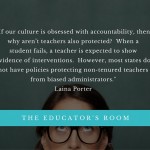[fusion_builder_container hundred_percent=”yes” overflow=”visible”][fusion_builder_row][fusion_builder_column type=”1_1″ background_position=”left top” background_color=”” border_size=”” border_color=”” border_style=”solid” spacing=”yes” background_image=”” background_repeat=”no-repeat” padding=”” margin_top=”0px” margin_bottom=”0px” class=”” id=”” animation_type=”” animation_speed=”0.3″ animation_direction=”left” hide_on_mobile=”no” center_content=”no” min_height=”none”]
To buy Cari’s book that details her sudden unemployment, “How to Finish the Test When Your Pencil Breaks” please click here.
Whether we teach small children, middle schoolers, high schoolers or adults, as educators, a huge responsibility falls upon us when public tragedies and major events occur. The terrible tragedy at the Boston Marathon reminds us that now a regularly-used skill that teachers must have is how to talk with students about these scary events and help them deal with the inevitable fears that follow.
When you speak with your students tomorrow, your already established relationships with them are key to the two main issues we face when communicating about terrifying situations like bombs and violence: how to help them understand the situation, and how to help them feel safe.
Here are a few things to keep in mind, and which we hope will provide you with some support this week:
- It’s Normal to Be Scared or Nervous. Your students will have heard about the events in Boston, possibly unless they are very young. With modern communication and technlogy, it’s hard to keep news events like this from kids. So it is natural they may be nervous about being in public spaces – even their parents may be nervous dropping them off at school. That is totally normal, and even while you may be feeling the same thing, you can still offer a haven of peace and safety in your classroom. Statistics tell us events like this are extremely rare, but that doesn’t make it any less scary – emotions are emotions, and it’s okay to acknowledge how scary it is.
- Take a Break from the News. While you may be interested in watching twenty-four-hour news for all the latest developments, your students don’t need that (and really, neither do you). Limiting the amount of time you spend watching the news reports will lessen your own anxiety and help prevent communication of unverified stories. Let your classroom be a refuge for both you and your students – your daily routine creates a safe space for all of you.
- Answer your Students’ Questions. Your students, especially older ones, will no doubt have heard many stories about this terrible event by the time you see them next. It’s okay to talk with them about it, but you first may want to be prepared with only verifiable facts, and respond to what they know, instead of feeding more information into the situation. If they misunderstand the situation, you can clarify for them, while reassuring them of their own distance from it. You don’t have to give a lot of details, and especially avoid this with younger children. Explaining that there was an explosion and people were hurt is honest, but you can do it with wisdom and understanding about your students and what is appropriate — especially by adding constant reassurance that it is not happening where you are.
- Pay Extra Attention to Your Students. Kids will respond differently to scary events like this – and you may see behavioral issues right away, or even delayed by a few days. Be extra observant of how your students are doing, what they are talking about, and how they are behaving so you can be aware of cues that will tell you whether you need to get your school counselor or administrators in to help – or maybe even just give parents a call.
- Model Confidence & Assurance. The events of a horrific event like the bombing in Boston may have knocked you off your balance — but you are still the role model for your students in the immediate aftermath of this. Modeling confidence and giving your students assurance that you are there for them, that you understand how scary it is, and that they can rely on you can be the most important thing for them right now.
- Take Action. Kids and adults can often feel better and more in control when they take action after an event like this. Most likely, there will be ways that you can engage your students in responding in a way that will allow them to participate as helpful fellow citizens provided by organizations on the scene and in the aftermath. Thanking first responders and talking about ways people helped, or how we can provide support give balance to the evil of an action like a bombing with the true goodness of people in a community. There is no requirement that you do this at all – it is only an option for one way to process the situation with your students by balancing the scary side of it with a positive focus.
- Take Care of Yourself. Being a nurturer is an often unacknowledged, but enormous, part of education for which there is no real training. There is no way to be prepared for horrible events like the violence that happened in Boston, or in Newtown. But we can be prepared to provide support for our students by making sure we care for our own inner stability. If you have experienced tragedy, and events like this trigger a higher level of fear and other emotions for you, get the help you need. Talk to someone, take time off, do what you need to do to care for yourself before you give more of yourself to your students. In the end, you can care more for them, provide the support they need, and guide them through one more tragic crisis if you first make sure you provide for your own needs.
There is no one “right” way to deal with events like this. The sad truth is, as educators, we are having to get more and more used to talking with our students about scary events. While we may not be able to control the fact that these things do happen – we can remind ourselves and our students that we do not have to live in fear as a result.[/fusion_builder_column][/fusion_builder_row][/fusion_builder_container]





